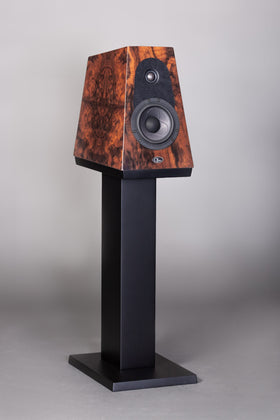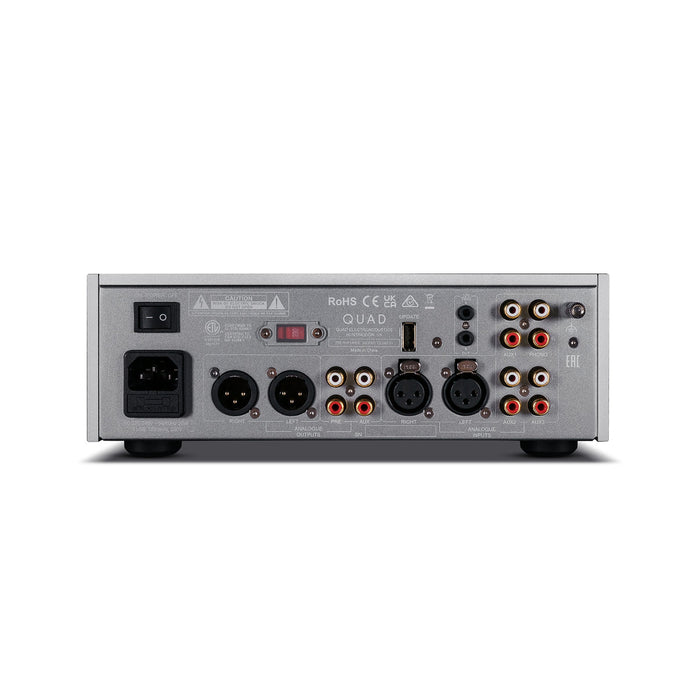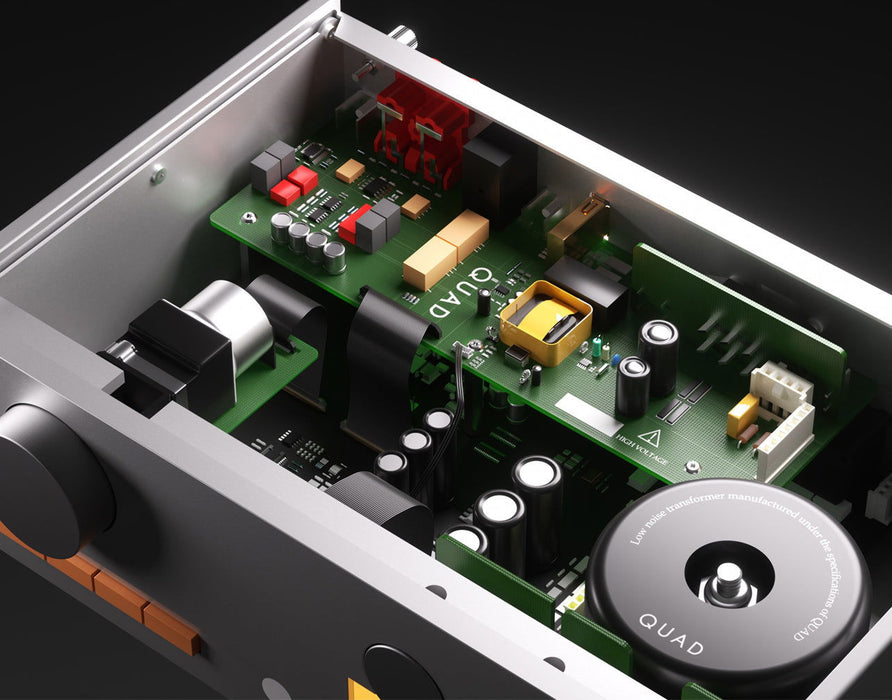
Quad 33 Preamplifier
Very few Hi-Fi components are as instantly recognisable as the QUAD 33 and 303, and for that we make no apologies!
Still one of the most popular models in the history of one of the world’s most poignant Hi-Fi brands, the QUAD 33 and 303 are benchmarks in almost every angle of desirable audio equipment – performance, reliability, industrial design, value and musical romance.
The external design is specifically intended to continue the QUAD tradition of practical simplicity. Yet, it would be foolish to ignore the implementation of modern-day capabilities, such as an informative backlit display, delicate LED illumination and remote control functionality. And just like the original, the overall appearance is unmistakably QUAD, albeit now with a premium machined and anodised front panel and all-metal chassis.
Function
The new QUAD 33 is supported by digital microprocessor control but is otherwise faithful to a classic analogue design.
The 33 feeds the loudspeakers via the power amplifier using dedicated stereo pre-outputs, with an RCA line-level and balanced XLR pre-out option. For additional versatility and functionality, there’s also an AUX output.
Now equipped with fully balanced XLR inputs and outputs, the 33 is set apart from other preamplifiers and even its forefather model.
The brand new phono stage is Moving Magnet and Moving Coil compatible with the ability to simply switch between the two options – no mods or board upgrades necessary. With a gain of 46dB for the MM and 63.5dB for the MC, the input stage uses ultra-low noise audio op-amps. This ultra-low noise performance is combined with high slew rates and very low distortion specifications. The RIAA processing circuit has its own dual Bipolar/JFET Audio Operational Amplifier. The JFET portion of the input stage enables high slew rates to keep distortion low, even when large output swings are required.
Controls
The controls are comprehensive but simple. Again, this echoes the original design concept. Logically grouped to facilitate selection and control of the programme, a backlit LCD screen relays settings, adjustments and values. The same backlighting principle is applied to each of the push buttons, further enhancing the intuitive design with a visual indication of input selection and mode. Illumination settings for buttons and the LCD screen allow for brightness adjustment, contrast adjustment, and a simple on/off setting to suit the user’s preference.
The master volume control is a fully analogue, precision motorised ALPS potentiometer offering long-life and low-noise performance. The volume control is not only tactile and precise; its motorised operation will automatically rotate when adjustments are made via the remote control. A further row of three endless rotary encoders offer intuitive and immediate control over the QUAD-specific fine-tuning settings.
The original QUAD 33, as with many previous and subsequent QUAD preamplifier components, offered filters considered essential for ‘modern good quality speakers’ (as was stated at that time). Such controls are no longer required; therefore, in applying modern-day logic and suitability to today's technology, the new QUAD 33 presents bass adjustment, tilt control and balance control to allow tuning to a fine degree without intruding unnecessarily into the harmonic range essential for realistic reproduction.
The bass control allows adjustment from-3dB to +3dB. Perfect for subtle adjustments in the low-end, as a solution to adding body to thinner source material. Or conversely, reducing bass tones in the event of room-affected 'boominess'. In comparison to the time of launch of the original QUAD 33, loudspeakers and source materials have evolved mainly for the better. This evolution saw the adoption of ‘Tilt’ control in the QUAD 33’ssuccessor, the QUAD 34 (1982).
Developed by QUAD founder, the legendary Peter Walker, the Tilt control is an audiophile-quality solution for adjusting tone. Its design stems from the belief that traditional tone and EQ controls are inadequate and clumsy when adjusting tonal balance.
The Tilt control differs in that it adjusts both ends of the frequency spectrum together, either attenuating the bass and lifting the treble, or lifting the bass and attenuating the treble in 1dB steps.
Essentially, it rotates – or tilts – the audible frequency range on a 700Hz axis, thereby adjusting the overall sound balance with 'warm' or 'cool' hints without altering volume or adding colour to the sound. This feature is unique to QUAD and offers a subtle, precise, and consistent way to adjust your system's performance and compensate for recordings or environments.
The Tilt control, Bass control, and Balance controls are all composed of low-noise op-amps, electronic switches, and MELF low-temperature coefficient metal film resistors, forming a negative feedback adjustment circuit.
Performance
No one knows more about the QUAD 33 than the immensely experienced QUAD service department – still based at QUAD HQ in Huntingdon, Cambridgeshire, England.
Upon initiating this project of passion, it was determined that the new 33 and 303 combination will only see the light of day if the performance stands true and improves on the original.
In over 50 years since the release of the original 33 and 303, innovations and developments have been exponential, but only some have been employed and each with good reason. Each stage of the development and every innovation was subject to thorough testing and complete agreement with the QUAD technical design AND service team.
It is bold but fair to claim that the low-noise, custom-specified toroidal transformer, numerous reservoir/smoothing capacitors, and an impressive number of regulators put the new QUAD 33 technically ahead of the original. The power supply incorporates five regulated supply rails, including multiple ultra-low-noise regulators with extensive measures employed to prevent contamination and cross-coupling. Following traditional QUAD practices, the core signal path is short and direct to preserve signal purity, and volume is adjusted purely in the analogue domain under microprocessor control. No one will champion the virtues of the original QUAD 33 more than QUAD, ourselves. However, side-by-side, technical innovations and improvements in signal processing cannot be denied.
Fit and Finish
The QUAD 33 has a crisp and clean aesthetic that evokes QUAD’s past yet sits in the modern-day with a futuristic accent. The housing is rigid and oozes quality. The end-finish is precise, just like the audio signal path. The anodised and custom-tooled fascia demonstrate the quality and level at which the new QUAD 33 will be recognised. No longer subject to cracks, fading or other issues associated with classic front panels, the QUAD 33 is ready for a lifetime of performance.
Ultimately, the new QUAD 33 considers every angle and aspect to underline the faithful evolution of the ‘33’ concept. With each step in transitioning from concept to reality, the commitment to ‘the closest approach to the original sound’ is evident.
Specifications
Dedicated Current-Feedback Headphone Amplifier
Inputs 3 x RCA, 1 x Balanced XLR (pair), 1 x Phono (MM/MC switchable)
Outputs 1 x RCA (AUX), 1 x XLR, 1 x RCA (Pre Out), 1 x Headphone, 2 x 12V Trigger Out
Pre Amplifier Section
Gain 0dB (Line / XLR)
+46dB (Phono MM)
+63.5dB (Phono MC)
Input Sensitivity (Vout=695mV) 695mV (Line / XLR)
3.2mV (Phono MM)
460uV (Phono MC)
Input Impedance 10k (Line / XLR)
47k/100pF (Phono MM)
100R/1.7nF (Phono MC)
Total Harmonic Distortion (THD) <0.0005% (1kHz, Line/XLR)
<0.002% (1kHz, Phono MM / MC)
Frequency Response 20Hz - 20kHz (+/-0.2dB)
Signal-to-Noise ratio (S/N) > 108dB (A-weighted, Line/XLR)
> 82dB (A-weighted, Phono MM)
> 74dB (A-weighted, Phono MC)
Output Impedance 120 ohms
Headphone Amplifier
Total Harmonic Distortion (THD) < 0.01% (1kHz, 50mW)
Output Impedance 2.35 ohms
Load Impedance 20 - 600 ohms
General
Standby Power Consumption <0.5W
Net weight 4kg
Gross weight 4.96kg
Dimensions (mm) (W x H x D) 258 x 165 x 82.9
Carton Size (mm) (W x H x D) 330 x 257 x 192
Finish Classic QUAD Grey
Power requirements (depending on region) 220 - 240V - 50 / 60Hz
100 - 120V - 50 / 60Hz
Standard accessories Power Cord, Remote Control, User Manual.





